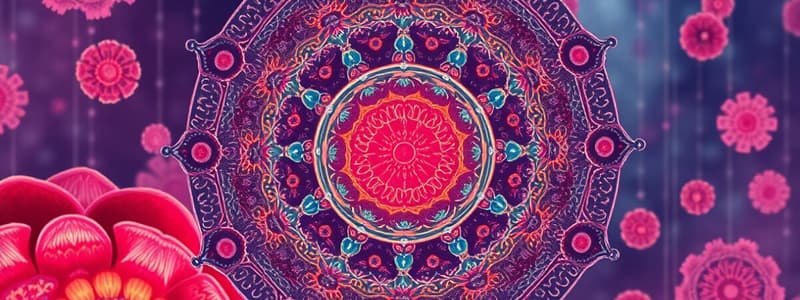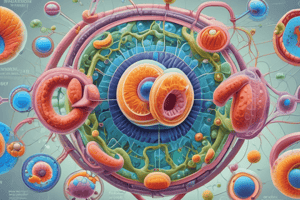Podcast
Questions and Answers
What is the primary function of mitosis?
What is the primary function of mitosis?
- To synthesize proteins
- To repair tissues only
- To duplicate the DNA
- To segregate chromosomes and divide the cell (correct)
Cytokinesis occurs only during the M phase of the cell cycle.
Cytokinesis occurs only during the M phase of the cell cycle.
True (A)
What is the role of the kinetochore during cell division?
What is the role of the kinetochore during cell division?
To attach chromatids to microtubules and assist in their movement to the poles of the cell.
The __________ phase of the cell cycle includes DNA duplication.
The __________ phase of the cell cycle includes DNA duplication.
Match the following stages of mitosis with their descriptions:
Match the following stages of mitosis with their descriptions:
Which phase of mitosis is characterized by the breakdown of the nuclear envelope?
Which phase of mitosis is characterized by the breakdown of the nuclear envelope?
How long does the M Phase typically last?
How long does the M Phase typically last?
Sister chromatids are separated during metaphase.
Sister chromatids are separated during metaphase.
What happens during telophase?
What happens during telophase?
Cytokinesis occurs after the completion of mitosis.
Cytokinesis occurs after the completion of mitosis.
What is the chromosome number in gametes produced through meiosis?
What is the chromosome number in gametes produced through meiosis?
Gametes are described as ______ because they contain one member of each chromosome pair.
Gametes are described as ______ because they contain one member of each chromosome pair.
Match the following terms with their definitions:
Match the following terms with their definitions:
Which statement accurately describes homologous chromosomes?
Which statement accurately describes homologous chromosomes?
The zygote is haploid in chromosome number.
The zygote is haploid in chromosome number.
What is the primary outcome of crossing-over during meiosis?
What is the primary outcome of crossing-over during meiosis?
What is the end product of meiosis in males?
What is the end product of meiosis in males?
In females, the two meiotic divisions of a primary oocyte produce three functional gametes.
In females, the two meiotic divisions of a primary oocyte produce three functional gametes.
What type of division occurs during meiosis II?
What type of division occurs during meiosis II?
The chromosome number is reduced from diploid (2n) to __________ (1n) during meiosis I.
The chromosome number is reduced from diploid (2n) to __________ (1n) during meiosis I.
Match the phases of meiosis I with their correct descriptions.
Match the phases of meiosis I with their correct descriptions.
During which stage of prophase I does crossing over occur?
During which stage of prophase I does crossing over occur?
No DNA replication occurs before meiosis II.
No DNA replication occurs before meiosis II.
What is a chiasma?
What is a chiasma?
What is the primary structural form of heterochromatin?
What is the primary structural form of heterochromatin?
Heterochromatin is transcriptionally active at all times.
Heterochromatin is transcriptionally active at all times.
What is a nucleosome composed of?
What is a nucleosome composed of?
The basic subunit of chromatin is known as a ______.
The basic subunit of chromatin is known as a ______.
Which of the following is associated with the regulation of gene expression or chromosome integrity?
Which of the following is associated with the regulation of gene expression or chromosome integrity?
Heterochromatin can influence the expression levels of adjacent genes.
Heterochromatin can influence the expression levels of adjacent genes.
The term for the inheritance mechanism involving heterochromatin is ______.
The term for the inheritance mechanism involving heterochromatin is ______.
What is the primary function of chromatin?
What is the primary function of chromatin?
Euchromatin is tightly packed and less accessible for transcription.
Euchromatin is tightly packed and less accessible for transcription.
What are the two types of chromatin mentioned?
What are the two types of chromatin mentioned?
Chromatin is composed of DNA and _____ proteins.
Chromatin is composed of DNA and _____ proteins.
What percentage of the human genome is composed of euchromatin?
What percentage of the human genome is composed of euchromatin?
During interphase, chromatin is more tightly packed to prevent transcription.
During interphase, chromatin is more tightly packed to prevent transcription.
What structural change occurs to chromatin during mitosis?
What structural change occurs to chromatin during mitosis?
Which of the following statements about euchromatin is true?
Which of the following statements about euchromatin is true?
Heterochromatin is only found in eukaryotes.
Heterochromatin is only found in eukaryotes.
What are the two main types of heterochromatin?
What are the two main types of heterochromatin?
The _______ chromosome is associated with facultative heterochromatin.
The _______ chromosome is associated with facultative heterochromatin.
How does heterochromatin affect nearby genes?
How does heterochromatin affect nearby genes?
Match the type of heterochromatin with its description:
Match the type of heterochromatin with its description:
Euchromatin is more densely packed than heterochromatin.
Euchromatin is more densely packed than heterochromatin.
What role does RNA-induced transcriptional silencing (RITS) play in heterochromatin?
What role does RNA-induced transcriptional silencing (RITS) play in heterochromatin?
Flashcards
G2 Phase
G2 Phase
A cell cycle phase where the cell prepares for mitosis by checking for DNA or other errors.
M Phase (Mitosis)
M Phase (Mitosis)
The phase of cell division that includes both karyokinesis (nuclear division) and cytokinesis (cell division).
Karyokinesis
Karyokinesis
The division of the nucleus during mitosis.
Cytokinesis
Cytokinesis
Signup and view all the flashcards
Prophase
Prophase
Signup and view all the flashcards
Metaphase
Metaphase
Signup and view all the flashcards
Anaphase
Anaphase
Signup and view all the flashcards
Chromatids
Chromatids
Signup and view all the flashcards
Cleavage Furrow
Cleavage Furrow
Signup and view all the flashcards
Contractile Ring
Contractile Ring
Signup and view all the flashcards
Diploid (2n)
Diploid (2n)
Signup and view all the flashcards
Haploid (1n)
Haploid (1n)
Signup and view all the flashcards
Meiosis
Meiosis
Signup and view all the flashcards
Crossing-over
Crossing-over
Signup and view all the flashcards
Meiosis in Males
Meiosis in Males
Signup and view all the flashcards
Meiosis in Females
Meiosis in Females
Signup and view all the flashcards
Reductional Division
Reductional Division
Signup and view all the flashcards
Equatorial Division
Equatorial Division
Signup and view all the flashcards
Prophase I Stages
Prophase I Stages
Signup and view all the flashcards
Leptotene
Leptotene
Signup and view all the flashcards
Zygotene
Zygotene
Signup and view all the flashcards
Pachytene
Pachytene
Signup and view all the flashcards
Nucleosome
Nucleosome
Signup and view all the flashcards
Euchromatin
Euchromatin
Signup and view all the flashcards
Heterochromatin
Heterochromatin
Signup and view all the flashcards
What role does chromatin play during cell division (mitosis/meiosis)?
What role does chromatin play during cell division (mitosis/meiosis)?
Signup and view all the flashcards
How does chromatin structure affect gene expression?
How does chromatin structure affect gene expression?
Signup and view all the flashcards
What are epigenetic modifications?
What are epigenetic modifications?
Signup and view all the flashcards
Why is chromatin structure an active research area?
Why is chromatin structure an active research area?
Signup and view all the flashcards
Constitutive Heterochromatin
Constitutive Heterochromatin
Signup and view all the flashcards
Facultative Heterochromatin
Facultative Heterochromatin
Signup and view all the flashcards
Position-Effect Variegation
Position-Effect Variegation
Signup and view all the flashcards
Satellite DNA
Satellite DNA
Signup and view all the flashcards
RNAi
RNAi
Signup and view all the flashcards
piRNA
piRNA
Signup and view all the flashcards
Position Effect Variegation (PEV)
Position Effect Variegation (PEV)
Signup and view all the flashcards
Insulator Sequences
Insulator Sequences
Signup and view all the flashcards
Histone Octamer
Histone Octamer
Signup and view all the flashcards
Study Notes
Cell Cycle Checkpoints
- Cell cycle checkpoints are control mechanisms in eukaryotic cell cycles
- They ensure proper progression
- Each checkpoint is a potential termination point assessing cell conditions
- Progression to the next phase only occurs under favorable conditions
- Key checkpoints: G1 (Start/restriction), G2/M, and metaphase-to-anaphase (spindle)
- Progression determined by cyclin-dependent kinases (CDKs) activated by cyclins
- Different cyclins produced at each cell cycle stage to control specific events
Phases of Cell Cycle
- A typical eukaryotic cell cycle (e.g., human cells in culture) lasts approximately 24 hours
- Duration varies between organisms and cell types (e.g., yeast in 90 minutes)
- Divided into interphase and mitotic (M) phase
- Interphase: cell growth and chromosome copying
- Mitotic phase: mitosis and cytokinesis
Interphase
- Consists of three phases: G1, S, and G2
- G1 phase: Longest and most variable; cell gathers nutrients, synthesizes RNA and proteins needed for DNA replication
- S phase: DNA synthesis; DNA contents are doubled, and new chromatids are formed (about 7.5-10 hours)
- G2 phase: Cell growth and reorganization of cytoplasmic organelles; cell checks for DNA replication errors; cells prepare to enter the mitotic cycle
Mitosis
- Mitosis: process of chromosome segregation and nuclear division followed by cell division. Creating daughter cells with the same DNA content.
- Stages Include:
- Prophase: Chromatin condense, visible chromosomes form, nuclear envelope breaks down
- Metaphase: Chromosomes align at the metaphase plate, spindle fibers attach to chromosomes
- Anaphase: Sister chromatids separate and move to opposite poles
- Telophase: Chromosomes decondense, nuclear envelope reforms, cytoplasm divides (cytokinesis)
Cytokinesis
- Cytokinesis: Cytoplasmic division that completes mitosis (formation of two daughter cells)
Meiosis
- Meiosis: Two sequential nuclear divisions to produce gametes (sex cells) with half the chromosome number and DNA content of somatic cells
- Important for genetic diversity and reproduction
- Meiosis differs in males and females: 1) Males- producing unique, haploid spermatids capable of differentiation into spermatozoa 2) Females- produces one haploid ovum and three haploid polar bodies
- Stages: Meiosis I and Meiosis II (with prophase, metaphase, anaphase and telophase phases) reducing the DNA content from (4d) to (1d)
Chromatin
- Chromatin: Complex of DNA and proteins found in eukaryotic cells, packaging DNA into a compact form
- Two types of chromatin: 1) Euchromatin: less compact, active transcription 2) Heterochromatin: more compact, less accessible for transcription
- Nucleosomes: DNA wrapped around histone proteins, the fundamental subunit of chromatin
- Importance in DNA packaging, regulation of gene expression, and maintaining chromosome integrity
Studying That Suits You
Use AI to generate personalized quizzes and flashcards to suit your learning preferences.




